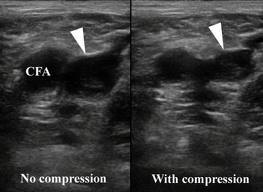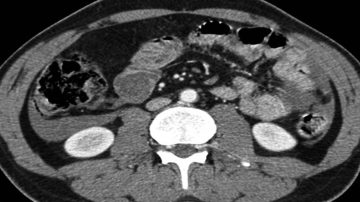Previous trials have shown that catheter-directed thrombolysis (CDT) for proximal deep vein thrombosis has a lower rate of post-thrombotic syndrome compared with systemic anticoagulation alone. However, a new retrospective cohort study shows that the mortality rates are equivalent and the rates of transfusion,…
Read MoreIn three single-center, randomized trials, oral contrast — given in addition to intravenous (IV) contrast — did not improve the diagnostic accuracy of computed tomographic (CT) scanning for suspected appendicitis. To determine whether this conclusion is generally valid, researchers analyzed…
Read MoreNew guidelines from the International Antiviral Society recommend antiretroviral therapy for ALL HIV-infected patients Sponsoring Organization: International Antiviral Society–USA (IAS-USA) Target Population: Clinicians who treat HIV-infected patients Key Recommendations Antiretroviral therapy (ART) is recommended for all HIV-infected patients, including those with acute HIV infection—but…
Read MoreSponsoring Organization: Ontario Neurotrauma Foundation Target Population: Healthcare professionals and others who deal with concussion, including physicians, neuropsychologists, physical therapists, family, and schools/community sports organizations Background and Objective The panel used an evidence-based, systematic review to standardize diagnosis, assessment, and management of…
Read MoreGuidelines recommend that patients with massive pulmonary embolism (PE) and hemodynamic instability be treated with thrombolysis (Circulation 2011; 123:1788). However, consensus is lacking on what to do in intermediate-risk patients (i.e., those who are hemodynamically stable but have right ventricular…
Read MoreMild hypothermia is standard of care for comatose survivors after cardiac arrest. Now there is new evidence that survivors of PEA arrest do better neurologically compared with survivors of VF/VT arrests. A retrospective, single-center study shows comatose survivors with shockable…
Read MoreA new randomized controlled trial refutes the theory that either Epogen or liberal transfusions will improve neurologic outcome in patients with traumatic brain injury. Head trauma occurs in 1.5 million Americans annually, at a cost of more than $56 billion. Erythropoietin…
Read MoreResults of the Syntax trial suggests that PCI and CABG have comparable results for most patients with left main disease. The results suggest that the all-cause mortality was lower with PCI vs CABG in patients with Syntax scores <=32, but…
Read MoreThere has always been some controversy about the utility of applying cricoid pressure (aka Sellick Maneuver) during rapid sequence intubation for the purpose of preventing aspiration. Theoretically, applying pressure on the cricoid cartilage posteriorly should occlude the esophagus against the…
Read MoreMore Tags – Deep vein thrombosis, deep venous thrombosis, DVT, DVT treatment, HPC updates, treatment
Outpatient treatment of acute DVT is as safe as inpatient treatment in patient’s with an adequate home situation. Cohort study of 13,500 patients diagnosed with an acute lower extremity DVT and treated with either low molecular weight heparin or fondaparinux.…
Read MorePreface: Patients with COPD exacerbations requiring ICU admission did better with low-dose steroids vs high-dose steroids Cohort study of 17,239 patients with COPD exacerbations admitted to the ICU * 1/3 required noninvasive ventilation * 15% were intubated * Virtually all…
Read MoreThe USPSTF continues to recommend screening primarily in 65- to 75-year-old men who have ever smoked. U.S. Preventive Services Task Force (USPSTF) Background Prevalence of abdominal aortic aneurysms (AAAs; defined by an aortic diameter of ≥3.0 cm) in adults older…
Read MoreIn a randomized trial, absorbable sutures achieved cosmetic results and complication rates similar to those of nonabsorbable sutures in both children and adults. Absorbable sutures have been demonstrated to be safe and effective for repair of facial lacerations (NEJM JW…
Read MoreFrequently the combination of a serum D-dimer level and compression ultrasound testing can differentiate between a residual venous clot and an acute recurrent DVT. However, sometimes the results are equivocal and in these situations an MRI direct thrombus imaging can…
Read MorePatients with minimal free fluid and no abdominal tenderness can be observed, while patients with moderate-large amounts of free fluid and abdominal tenderness should undergo operative exploration. To determine if operative exploration or observation is the preferred management for hemodynamically…
Read MoreCategories
- ACLS (1)
- Arterial line (33)
- Cardiovascular diseases (77)
- Central line (55)
- Chest Tube (39)
- Dermatology (4)
- Emergency Procedures (139)
- Endocrinology (6)
- Endotracheal Intubation (36)
- Events (24)
- FAST Exam (12)
- Featured (113)
- Featured Procedure (42)
- Gastrointestinal diseases (32)
- Ginecology (3)
- Glidescope Intubation (21)
- Hematology (33)
- Hospital Procedures (85)
- Infections (32)
- Intraosseous line (8)
- King Tube (27)
- Laryngeal Mask Airway (18)
- Lumbar Puncture (36)
- Mechanical Ventilation (34)
- Medical General (95)
- medical procedures (258)
- Needle Decompression (6)
- Nephrology (11)
- Neurological diseases (12)
- Oncology (4)
- Paracentesis (32)
- Pericardiocentesis (3)
- Procedural Sedation (19)
- Respiratory diseases (85)
- RUSH Exam (8)
- Thoracentesis (37)
- Traumatology (24)
- Travel (27)
- Ultrasound-Guided Peripheral IV (13)











